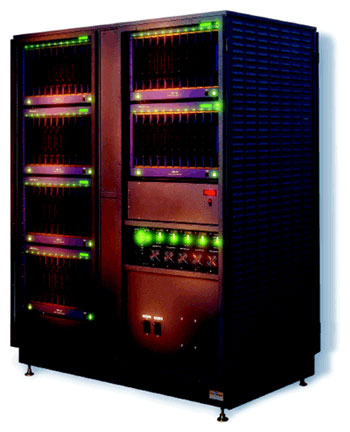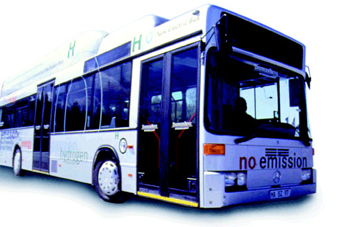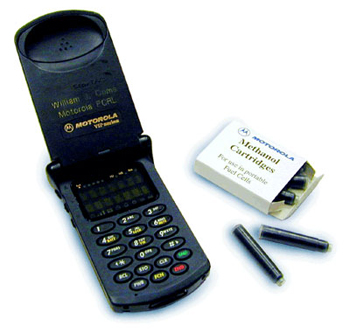A fuel cell is an electrochemical device that combines hydrogen and oxygen to produce electricity, with water and heat as the by-product. A fuel cell is similar in structure to a battery but it does not run down, nor does it require recharging — as long as hydrogen is supplied, it will continue to operate. The conversion of the fuel (hydrogen) to energy takes place without combustion; therefore the process is highly efficient, clean and quiet.
Fuel cells are really a family of technologies. Five major types, characterized by their electrolytes, are being developed: Proton Exchange Membrane (PEMFC), Alkaline (AFC), Phosphoric Acid (PAFC), Molten Carbonate (MCFC) and Solid Oxide (SOFC). Direct Methanol Fuel Cells (DMFCs) are a type of PEMFC that directly uses methanol as the fuel.
A fuel cell consists of two electrodes separated by an electrolyte. In most cases, hydrogen fuel is fed into the anode of the fuel cell. Oxygen (or air) enters the fuel cell at the cathode. Encouraged by a catalyst, the hydrogen splits into protons and electrons. The protons pass through the electrolyte. The electrons must take the long way around, creating a separate current that can be utilized before they return to the cathode, to be reunited with the hydrogen and oxygen to form a molecule of water. Individual cells are “stacked” together to generate useful quantities of power.
Higher temperature systems (MCFC, SOFC, PAFC) tend to be best suited to larger applications, while low temperature systems (PEMFC, DMFC, AFC) can be configured to provide as little as a few watts of power, or less. All fuel cells are modular. Units ranging in size from a few kilowatts to approximately 250 kW can be used as building blocks for larger systems.

Photo 1. Japan’s Asahi brewery is generating some of its own power with a fuel cell running on hydrogen from the methane gas produced in its brewing process
Fuel Flexibility
Because of their fuel flexibility, fuel cells can promote energy diversity and a transition to renewable energy sources. A fuel cell system that includes a “fuel reformer” can utilize the hydrogen from any hydrocarbon fuel – natural gas, ethanol, methanol, and even gasoline. Hydrogen can also be produced using wind- or solar-powered electrolysis, or it can be extracted from “novel” feedstocks such as landfill gas or anaerobic digester gas from wastewater treatment plants. Fuel cells can also utilize ammonia and boron compounds for fuel. Japan’s Asahi brewery is generating some of its own power with a fuel cell running on hydrogen from the methane gas produced in its brewing process (see photo 1).
Applications for Fuel Cells
Fuel cells can be made to suit a wide variety of power needs. Stationary power applications include power for buildings such as residential or commercial properties. Transportation applications range from off-road utility vehicles to golf carts, cars and buses, and even locomotives and boats. Portable applications include power for small electronic devices such as laptop computers, cellular telephones, and video cameras.
Stationary/Distributed Power Applications
An estimated two billion people living in rural areas around the globe currently have no access at all to the power grid. The U.S. government expects worldwide electrical consumption to rise from 12 trillion kilowatt- hours in 1996, to 22 trillion kilowatt-hours by the year 2020. Developing nations are expected to account for 43 percent of the world’s energy consumption as compared to only 28 percent in 1996.
The option of distributed power supply, also called “microgeneration,” is gaining converts as a more sensible approach than traditional grid systems. Fuel cells are considered an important emerging distributed generation technology.
Benefits of Fuel Cells for Stationary/Distributed Power Applications
Poised at the threshold of commercialization, fuel cells promise high efficiency, high reliability, low emissions, fuel flexibility, adaptability to specialized application and very high power quality. Ultimately, fuel cells, in combination with solar and wind power technologies, offer the promise of a totally zero emission energy system.
Fuel cell systems can provide on-site power, easing the strain on the existing centralized power grid, and reducing inefficiencies due to transmission losses. The modularity of fuel cells allows for incremental buildup of capacity where there is minimal funding available for the up-front capital costs of multi-megawatt sized or centralized power plants. And they can be configured to provide backup power to a grid connected customer, should the grid fail.
Because fuel cells generate heat as a by-product, there are co-generation possibilities for fuel cells installed on-site. The potential total efficiency of these Combined Heat and Power (CHP) systems can exceed 80 percent.
Fuel cells are environmentally preferable to traditional power generation technologies. The first commercially available fuel cell power plants, produced by International Fuel Cells, create less than one ounce of pollution per 1,000 kilowatt hours of electricity produced — compared to the 25 pounds of pollutants for conventional combustion generating systems. Fuel cell power plants are so clean, some areas of the United States have exempted them from air permit requirements.
The high reliability of fuel cells makes them an attractive option for businesses that are willing to pay a premium for power because the costs of losing power are great. According to Contingency Planning Research (1996), the average cost of down time for Credit Card Operations is $6.48 million per hour. An Alaska mail processing center installed five fuel cells, totaling 1 MW, as the primary source of power. If there is a grid outage, the installation will automatically operate as an independent system, continuing to power the facility.
Status of Development

Photo 2. On the way are units for homes
Fuel cell power plants, built by International Fuel Cells, are currently available in a modular 200 kW size that is “stackable” depending on load, and can run on natural gas or waste methane gas. Siemens Westinghouse, FuelCell Energy and other developers are demonstrating fuel cell power plants for stationary applications around the world.
On the way are units for homes (see photo 2). IdaTech is delivering 110 residential fuel cell units to Bonneville Power for demonstration in the Northwestern United States. Long Island Power Authority will be demonstrating 75 fuel cell units produced by Plug Power. And H Power received an order for 12,300 fuel cells from Energy Co-Opportunity, a consortium of rural electric cooperatives, which expects to begin marketing and installing the units by the end of 2001.
Transportation Applications
Annual Vehicle Miles Traveled (VMT) continue to rise and the number of vehicles on (and off) the road worldwide is increasing dramatically. All of this adds up to a greater demand for transportation fuels, an ever-increasing strain on natural resources, and greater amounts of pollutants entering the environment.
Even though there has been progress in reducing pollution emitted by newer vehicles, those gains are offset by the increased amount of driving and the rising number of vehicles on the roads. There are days when vehicles are banned from the downtown areas of Rome, Paris, Athens and Mexico City due to high pollution. In many major cities, scooters with two-stroke engines are significant contributors to smog.
Benefits of Fuel Cells for Transportation Applications
Fuel cell passenger vehicles are expected to be two to three times more efficient than internal combustion engines. The increased efficiency of fuel cell technology, as well as its ability to use cleaner fuels like natural gas and methanol in addition to renewable fuels, means less pollution per mile traveled, and less dependence on petroleum.
Using fuel cells in locomotives, buses or heavy-duty trucks means air conditioning and heating units can be powered without having to idle the diesel engines. Tests performed on Georgetown University’s second generation fuel cell bus, using methanol as the fuel, showed zero emissions of particulate matter and hydrocarbons, and near-zero emissions of carbon monoxide and nitrous oxides — levels far below the 1998 emission standard for buses.
Status of Development

Photo 3. Fuel cell transit bus demonstrations are ongoing in the United States, Canada, and Germany
Every major auto company in the world is evaluating the use of fuel cells in passenger vehicles, and almost all of them are testing fuel cell concept cars on the road. Current fuel cell demo vehicles are running on hydrogen or methanol, and advances have recently been made in the reforming of gasoline for use in fuel cells. Fuel cell transit bus demonstrations are ongoing in the United States, Canada, and Germany (see photo 3).
In the area of heavy-duty vehicle applications, Freightliner is demonstrating a Class 8 truck with a fuel cell auxiliary power unit. The fuel cell will allow the truck driver to run air conditioning, a television, or other appliances without having to idle the engine or drain the battery.
Fuel cell powered boom lifts, forklifts, golf carts and utility vehicles are being demonstrated around the world. BMW has said it will develop hydrogen fueled fuel cell forklift trucks, deploying about 2,000 in the company’s own facilities before marketing them to other users.
Fuel cells are also being demonstrated on small passenger boats, and Siemens has built and tested a fuel cell that is to be used in all of the German Navy’s future 212-class submarines, due to be commissioned beginning in 2003.
Portable Power Applications

Photo 4. Manufacturers including Sony, Motorola, Manhattan Scientifics, and NEC are developing fuel cells for devices including cellular telephones and handheld computers
Fuel cells are also receiving a lot of attention as potential battery replacements for portable electronic devices. Manufacturers including Sony, Motorola, Manhattan Scientifics, and NEC are developing fuel cells for devices including cellular telephones and handheld computers (see photo 4).
Benefits of Fuel Cells for Portable Power Applications
Allied Business Intelligence’s report on “Portable Fuel Cell Markets” says portable fuel cells are being developed to respond to the “poor performance of rechargeable batteries by quadrupling the run time before refueling is necessary.”
Manhattan Scientifics expects a fuel cell powered cell phone to have up to 200-hours of talk time. Recharging fuel cell powered electronic devices could be as simple as inserting a small cartridge of methanol (like a new ink cartridge in a pen), instead of waiting several hours for a battery to recharge, or carrying replacement batteries. The U.S. Army is looking into fuel cells to replace batteries for powering field equipment.
Status of Development
Ballard Power Systems is planning a commercial portable fuel cell product for the end of 2001. The company is teamed with Coleman Powermate on the development of portable fuel cell power generators. Motorola is developing direct methanol fuel cells (DMFCs), which would not require a separate “reformer” for extracting hydrogen from methanol fuel.
ABI’s report projects that “wireless handsets are the initial market for the first wave of portable fuel cells,” starting with 50,000 units shipped in 2002, and ramping up to 200 million units by 2007.
Conclusion
The United States is in the process of deregulating its electricity market; developing countries have also begun to privatize electrical markets. But there are many taxes, exit fees, subsidies and regulations in existence that make it difficult for microgeneration technologies to compete with grid power. Harmonization of standards of electrical production at the national level as well as the international level would help open systems to competition and bring the benefits of micropower to the citizens who need them.
On the vehicle side, issues of fueling infrastructure are critical and must be addressed. While reformers are being developed to allow fuel cells to be used with the existing fueling infrastructure, research and development must also focus on facilitating the distribution of cleaner alternative transportation fuels. Infrastructure issues for fuel cell buses are not such a concern, since the vehicles are refueled at a central location.
The efficiency, reliability and environmental benefits of fuel cells make it a key technology for all types of power needs. The unique qualities of fuel cell technology make it an attractive option for powering homes and buildings, vehicles, and a multitude of electronic devices — allowing world economies to thrive without putting further strain on the environment or its natural resources.







Find Us on Socials